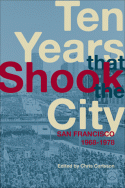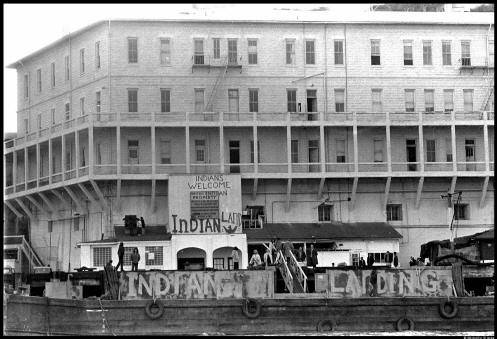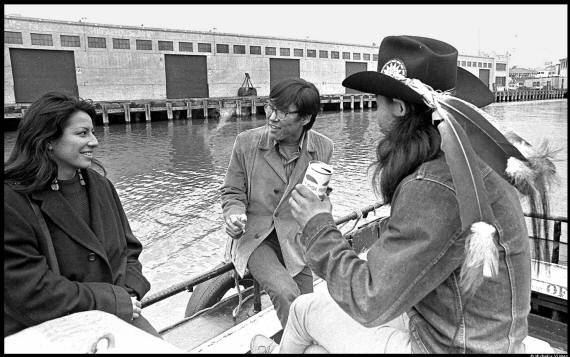Reflections from Occupied Ohlone Territory
Historical Essay
by Mary Jean Robertson
Listen to an excerpt from "Reflections from Occupied Ohlone Territory" read by author Mary Jean Robertson:
<embed src="http://www.archive.org/flow/flowplayer.commercial-3.2.1.swf" type="application/x-shockwave-flash" width="640" height="26" allowfullscreen="true" allowscriptaccess="always" cachebusting="true" bgcolor="#000000" quality="high" flashvars="config={'key':'#$aa4baff94a9bdcafce8','playlist':[{'url':'04MaryJeanRobertson16thStreetAndMissionMastered2.mp3','autoPlay':false}],'clip':{'autoPlay':true,'baseUrl':'http://www.archive.org/download/4TenYears--fromOccupiedOhloneTerritory/'},'canvas':{'backgroundColor':'#000000','backgroundGradient':'none'},'plugins':{'audio':{'url':'http://www.archive.org/flow/flowplayer.audio-3.2.1-dev.swf'},'controls':{'playlist':false,'fullscreen':false,'height':26,'backgroundColor':'#000000','autoHide':{'fullscreenOnly':true},'scrubberHeightRatio':0.6,'timeFontSize':9,'mute':false,'top':0}},'contextMenu':[{},'-','Flowplayer v3.2.1']}"> </embed>
by mp3.
![]()
Previous stop: Labor sights and smells
Next Stop #5: Underground comix
Just as when a pot of water is put on the stove to boil, and a few air bubbles form on the bottom and crawl up the sides of the pot, the Alcatraz Occupation had a few early attempts. In 1964 a group of young people landed on the Island and claimed it by right of the Sioux treaty of 1868. This claim was taken to Federal Court. Judges are very conservative, they could have determined that the Ohlone people were the original inhabitants of San Francisco and returned the land to them. Instead the court determined that the treaty only applied to the Sioux and other signatories of that treaty and did not apply to the West Coast at all. Again on November 9, 1969, Adam Fortunate Eagle, Richard Oakes, and others took a symbolic cruise around the Island on the Monte Cristo. Halfway around the Island Richard took off his shirt and dove into the water to swim to Alcatraz; he was followed by several others. Joe Bill, an Alaska Native familiar with the sea jumped when the boat was a little further along so that the tide would carry him to the Island. His was the only successful landing of that cruise. Later that night 14 activists spent the night on the island only to be returned to the mainland by the Coast Guard on the following morning. The 18-month occupation really started on November 20, 1969, at about 2:00 a.m., when almost eighty American Indians from more than 20 tribes landed on Alcatraz. Some stayed for the full 18 months of the occupation, some only for a day or two, but in the end over 5,600 Indians of All Tribes claimed “the Rock.”
A sign on the Alcatraz landing welcomes arriving Indian people.
From the great gallery of Alcatraz occupation images at Indigenous People of Africa and America online magazine.
Indian people sit in the back of a boat leaving for Alcatraz Island. LaNada Boyer, left, talks with Joe Bill, center, and an unidentified man.
Alcatraz changed everything. The event resulted in major benefits for American Indians. In his memoirs, Brad Patterson, a top aide to President Richard Nixon, cited at least ten major policy and law shifts. (Bradley H. Patterson, Jr. The White House Staff: Inside the West Wing and Beyond (Brookings Institution Press; Rev Upd edition, May 2000).) They include passage of the Indian Self-Determination and Education Assistance Act in 1975, a revision of the Johnson O’Malley Act to better educate Indians, passage of the Indian Financing Act of 1974, passage of the Indian Health Care Improvement Act in 1976, and the creation of an Assistant Interior Secretary post for Indian Affairs. Mount Adams was returned to the Yakima Nation in Washington State, and 48,000 acres of the Sacred Blue Lake lands were returned to Taos Pueblo in New Mexico. This was the very first return of land to the Indian Nations. During the Island’s Occupation second Christmas, Nixon signed papers rescinding Termination stating, “This marks the end of Termination and the start of Self-determination.”
Almost a month into the occupation, KPFA—and the other Pacifica Stations, KPFK in Los Angeles and WBAI in New York—broadcast the show Radio Free Alcatraz for 15 minutes a night to about 100,000 listeners. John Trudell was the voice from Alcatraz, covering Indian issues, interviewing residents, arranging talks on culture, fishing rights, the taking of Indian lands, and allowing the elders to tell the stories that had been passed down from generation to generation. This began a tradition of community radio that linked the Bay Area with the ongoing struggles across the country.
The Native college students would leave the island to attend their classes and to participate in founding the Ethnic Studies program in Berkeley and San Francisco State. They would return to Alcatraz on the weekends bringing the support of other students and community members. The negotiations dragged on into 1971 with the Government shutting off all electricity and removing the water barge which had provided fresh water to the occupiers. Three days later a fire broke out on the island. Several historic buildings were destroyed. The government blamed the Indians; the Indians blamed undercover government infiltrators trying to turn non-Indian support against them. Finally on June 10, 1971, armed federal marshals, FBI agents, and Special Forces police swarmed the island and removed five women, four children, and six unarmed Indian men. The occupation was over.
by Mary Jean Robertson, from her essay "Reflections from Occupied Ohlone Territory," in the anthology "Ten Years That Shook the City: San Francisco 1968-78" (City Lights Foundation: 2011), edited by Chris Carlsson.
 Find the book at City Lights!
Find the book at City Lights!



